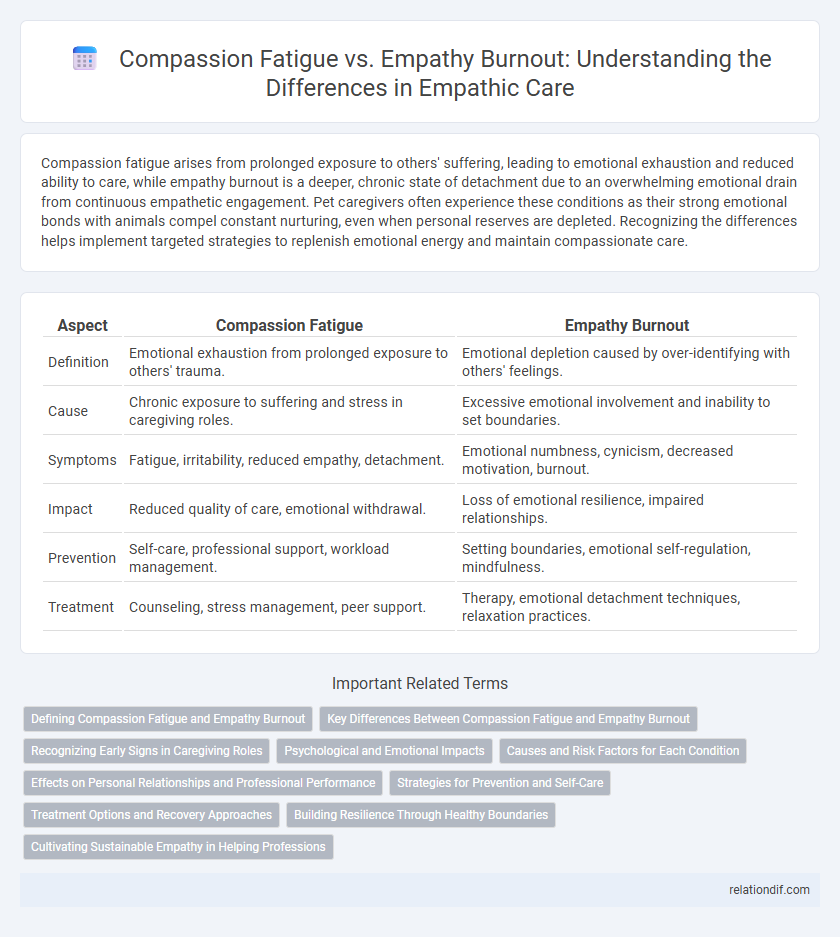Compassion fatigue arises from prolonged exposure to others' suffering, leading to emotional exhaustion and reduced ability to care, while empathy burnout is a deeper, chronic state of detachment due to an overwhelming emotional drain from continuous empathetic engagement. Pet caregivers often experience these conditions as their strong emotional bonds with animals compel constant nurturing, even when personal reserves are depleted. Recognizing the differences helps implement targeted strategies to replenish emotional energy and maintain compassionate care.
Table of Comparison
| Aspect | Compassion Fatigue | Empathy Burnout |
|---|---|---|
| Definition | Emotional exhaustion from prolonged exposure to others' trauma. | Emotional depletion caused by over-identifying with others' feelings. |
| Cause | Chronic exposure to suffering and stress in caregiving roles. | Excessive emotional involvement and inability to set boundaries. |
| Symptoms | Fatigue, irritability, reduced empathy, detachment. | Emotional numbness, cynicism, decreased motivation, burnout. |
| Impact | Reduced quality of care, emotional withdrawal. | Loss of emotional resilience, impaired relationships. |
| Prevention | Self-care, professional support, workload management. | Setting boundaries, emotional self-regulation, mindfulness. |
| Treatment | Counseling, stress management, peer support. | Therapy, emotional detachment techniques, relaxation practices. |
Defining Compassion Fatigue and Empathy Burnout
Compassion fatigue is the physical, emotional, and psychological impact of helping others, often characterized by deep exhaustion and a reduced capacity to show compassion. Empathy burnout occurs when prolonged exposure to others' suffering leads to emotional depletion and detachment, impairing empathetic engagement. Both conditions result in diminished empathy but differ in their causes and manifestations, with compassion fatigue linked to caregiving stress and empathy burnout tied to emotional overload.
Key Differences Between Compassion Fatigue and Empathy Burnout
Compassion fatigue primarily arises from prolonged exposure to others' suffering, leading to emotional exhaustion and reduced capacity to empathize, whereas empathy burnout stems from an overwhelming personal emotional involvement that drains one's ability to connect empathetically. Key differences include compassion fatigue often manifesting as detachment and numbness, while empathy burnout results in feelings of being emotionally overwhelmed and mentally drained. Understanding these distinctions is crucial for effective self-care and maintaining emotional well-being in caregiving professions.
Recognizing Early Signs in Caregiving Roles
Recognizing early signs of compassion fatigue and empathy burnout in caregiving roles involves monitoring emotional exhaustion, reduced capacity for empathy, and feelings of detachment or cynicism. Caregivers may experience persistent fatigue, irritability, and a diminished sense of accomplishment, which can impair their ability to provide effective support. Early identification through self-awareness and supportive workplace interventions can prevent long-term psychological consequences and maintain caregiver well-being.
Psychological and Emotional Impacts
Compassion fatigue and empathy burnout both significantly affect psychological and emotional well-being, causing symptoms such as chronic exhaustion, decreased motivation, and emotional numbness. Compassion fatigue typically arises from prolonged exposure to others' trauma, leading to feelings of helplessness and detachment, while empathy burnout stems from excessive emotional investment and chronic stress, resulting in reduced empathy capacity and increased cynicism. These conditions contribute to anxiety, depression, and impaired emotional regulation, ultimately hindering effective interpersonal connections and professional performance.
Causes and Risk Factors for Each Condition
Compassion fatigue arises primarily from prolonged exposure to others' trauma and emotional pain, often affecting healthcare workers and caregivers who experience continuous emotional strain. Empathy burnout occurs due to chronic emotional overinvestment and inability to set boundaries, leading to emotional exhaustion and detachment. Key risk factors include high workloads, lack of support, and personal vulnerability to stress, with compassion fatigue linked more to secondary traumatic stress and empathy burnout tied to chronic emotional depletion.
Effects on Personal Relationships and Professional Performance
Compassion fatigue and empathy burnout both negatively impact personal relationships and professional performance, causing emotional exhaustion, reduced patience, and decreased ability to connect with others. Individuals experiencing these conditions often struggle with detachment, increased irritability, and diminished job satisfaction, leading to impaired communication and collaboration in the workplace. Restoring balance through self-care and professional support is essential to prevent long-term damage to interpersonal dynamics and career effectiveness.
Strategies for Prevention and Self-Care
Compassion fatigue and empathy burnout require targeted prevention strategies such as setting clear emotional boundaries and engaging in regular self-reflection to maintain mental resilience. Prioritizing self-care practices like mindfulness meditation, physical exercise, and adequate rest replenishes emotional energy and reduces stress levels. Implementing peer support groups and professional counseling fosters a supportive environment that bolsters empathy endurance and overall well-being.
Treatment Options and Recovery Approaches
Treatment options for compassion fatigue often include cognitive behavioral therapy (CBT), mindfulness practices, and peer support groups to help individuals process emotional exhaustion and restore resilience. Empathy burnout requires comprehensive approaches such as professional counseling, stress management techniques, and structured self-care routines to rebuild emotional capacity and prevent detachment. Recovery approaches emphasize regular supervision, setting boundaries, and fostering work-life balance to sustain empathy without compromising mental health.
Building Resilience Through Healthy Boundaries
Compassion fatigue and empathy burnout both stem from prolonged exposure to others' suffering, but compassion fatigue primarily impacts caregivers emotionally through secondary trauma, while empathy burnout results from emotional exhaustion due to excessive empathic engagement. Building resilience through healthy boundaries involves setting clear limits on emotional involvement, practicing self-care, and maintaining professional distance to preserve emotional energy and mental health. Strategies such as mindfulness, regular debriefing, and prioritizing personal well-being help prevent the depletion of empathy resources and sustain effective caregiving.
Cultivating Sustainable Empathy in Helping Professions
Compassion fatigue and empathy burnout both result from prolonged exposure to others' suffering, yet compassion fatigue specifically refers to emotional exhaustion from helping, while empathy burnout encompasses a broader depletion of empathic capacity. Cultivating sustainable empathy in helping professions involves implementing regular self-care, professional boundaries, and reflective practices to maintain emotional resilience. Training programs emphasizing emotional regulation and peer support also play a critical role in preventing empathy-related decline and fostering long-term well-being.
Compassion fatigue vs empathy burnout Infographic

 relationdif.com
relationdif.com